Prediction and Interpretative Analysis of Bed Expansion Ratio in Pulsed Fluidized Beds
Abstract
1. Introduction
2. Experimental and Material Section
3. Theoretical Analysis of Bed Expansion in Pulsed Fluidized Beds
4. Description of the Machine Learning Process
4.1. Refinement of Feature Parameters
4.2. Basic Data Processing
4.3. SHAP Value
5. Evaluation of Prediction Accuracy in Machine Learning
5.1. Ridge Regression Model
5.2. BP Neural Network Model
5.3. XGBoost Model
6. Conclusions
- (1)
- As the particle size, density, and bed height increase, the bed expansion ratio continuously decreases. Conversely, an increase in gas velocity leads to a sustained rise in the bed expansion ratio. Furthermore, when the inherent frequency of the bed reaches a specific fixed value, an increase in pulsation frequency results in an initial increase, followed by a decrease in bed height.
- (2)
- In evaluating the model’s performance, XGBoost exhibited the highest prediction accuracy; for training sets utilizing original parameters, its R2 value was 0.9909. In the testing set, this R2 value reached 0.9888. When dimensionless data were used for both training and testing purposes, the R2 value for the training set was 0.9907, while that for the testing set was 0.9300.
- (3)
- SHAP value analysis indicates a positive correlation between gas velocity and bed expansion ratio, whereas particle diameter and density exhibit a negative correlation with it. The influences of bed height and pulsation frequency are relatively weak. For dimensionless numbers, f/fn has a significant impact on the expansion ratio, while H0/D shows a minimal influence.
Author Contributions
Funding
Data Availability Statement
Conflicts of Interest
Nomenclature
| AD | Area of single hole on air distributor, m2. |
| Ar | Archimedes number. |
| d | Particle diameter: m. |
| Mean bubble diameter, m. | |
| D | Diameter of the fluidized bed, m. |
| f | Pulsation frequency: Hz. |
| fe | Proportion of emulsion phase. |
| fn | Natural frequency: Hz. |
| fk | The k-th regression tree. |
| The calculation of the sample mean solely based on the feature set. | |
| The mean value of the samples based on the feature set S, with the addition of feature i. | |
| The predicted value of the sample within the decision tree. | |
| g | Gravitational acceleration, m/s2. |
| H | Bed expansion height, m. |
| Hmf | The bed height at the minimum fluidization velocity, m. |
| H0 | Initial bed height, m. |
| i | The i-th element. |
| k | The k-th tree. |
| K | The total number of regression trees. |
| M | The total number of features. |
| n | The number of samples. |
| N | The complete set of samples within the data set. |
| Re | Reynolds number. |
| S | A subset extracted from M. |
| The dimensionality of S. | |
| u | Gas velocity: m/s. |
| umf | Minimum fluidization velocity, m/s. |
| ub | Rising velocity of the bubble group, m/s. |
| ubr | Rising velocity of a single bubble, m/s. |
| xn | The feature vector of the data. |
| The predicted values for the samples. | |
| Y | Correction factor. |
| The number of features included in the decision path corresponding to this sample. | |
| Greek symbols | |
| δ | Proportion of the bubble phase. |
| ϕ0 | The baseline value provided via the model. |
| ϕi | The contribution of the i-th feature. |
| β | Damping factor: s−1. |
| ρp | Particle density: kg/m3. |
Abbreviations
| AE | Acoustic emission. |
| ANNs | Artificial neural networks. |
| BP | Backpropagation. |
| CGT | Cooperative game theory. |
| RFs | Random forests. |
| RMSE | Root mean square error. |
| GA | Genetic algorithm. |
| GBDT | Existing gradient boosting decision tree. |
| ML | Machine learning. |
| MSE | Mean squared error. |
| SHAP | Shapley additive explanation. |
| XGBoost | Extreme gradient boosting. |
References
- Zhang, K.; Wang, S.; Li, B.; He, Y.; Zhao, Y. Heat transfer in a pulsed fluidized bed by using coupled CFD-DEM method. Powder Technol. 2020, 367, 497–505. [Google Scholar]
- Ali, S.S.; Asif, M.; Ajbar, A. Bed collapse behavior of pulsed fluidized beds of nano-powder. Adv. Powder Technol. 2014, 25, 331–337. [Google Scholar]
- Sung, W.C.; Jung, H.S.; Bae, J.W.; Kim, J.Y.; Lee, D.H. Segregation phenomena of binary solids in a pulsed fluidized bed. Powder Technol. 2022, 410, 117881. [Google Scholar]
- Li, Y.; Hong, K.; Zhou, C.; Zhang, Y.; Dong, L. Resonance-induced particle mixing and segregation phenomena in a forced oscillation fluidized bed. Chem. Eng. Sci. 2024, 299, 120448. [Google Scholar]
- Li, X.; Zhang, R.; Yao, Q.; Meng, X.; Sun, Z.; Li, Z.; Qiu, F.; Li, P.; Zhou, E. Catalytic effects of key compositions in biomass ashes on coal gasification reactivity and structural evolution characteristic during gasification process. J. Clean. Prod. 2025, 499, 145197. [Google Scholar]
- Chen, H.; Zhu, L.; Song, Y.; Liu, Z.; Wang, X.; Zhao, C.; Lu, X. Study on flow characteristics of bidirectional sinusoidal liquid pulsed gas-liquid-solid multiphase fluidized bed. Chem. Eng. Res. Des. 2022, 183, 104–117. [Google Scholar]
- Francia, V.; Wu, K.; Coppens, M.-O. On the role of energy dissipation in a dynamically structured fluidized bed. Chem. Eng. Sci. 2022, 248, 117189. [Google Scholar]
- Liu, Y.; Ohara, H.; Tsutsumi, A. Pulsation-assisted fluidized bed for the fluidization of easily agglomerated particles with wide size distributions. Powder Technol. 2017, 316, 388–399. [Google Scholar]
- Ali, S.S.; Al-Ghurabi, E.H.; Ajbar, A.; Mohammed, Y.A.; Boumaza, M.; Asif, M. Effect of frequency on pulsed fluidized beds of ultrafine powders. J. Nanomater. 2016, 2016, 4592501. [Google Scholar]
- Li, Y.; Zhou, C.; Yang, L.; Lv, G.; Ren, Y.; Zhao, Y. Prediction of Bed Density in a Pulsed Gas–Solid Fluidized Bed. Ind. Eng. Chem. Res. 2021, 61, 968–976. [Google Scholar]
- Machado, V.; Hirata, T.; Menegalli, F. Agglomeration of soy protein isolate in a pulsed fluidized bed: Experimental study and process optimization. Powder Technol. 2014, 254, 248–255. [Google Scholar] [CrossRef]
- Wu, K.; de Martín, L.; Coppens, M.-O. Pattern formation in pulsed gas-solid fluidized beds—The role of granular solid mechanics. Chem. Eng. J. 2017, 329, 4–14. [Google Scholar] [CrossRef]
- Hirata, T.A.M.; Dacanal, G.C.; Menegalli, F.C. Effect of operational conditions on the properties of pectin powder agglomerated in pulsed fluid bed. Powder Technol. 2013, 245, 174–181. [Google Scholar] [CrossRef]
- Zhu, L.; Chen, H.; Song, Y.; Shi, R.; Liu, Z.; Wei, X.; Zhao, C.; Ai, T. Study on flow characteristics of gas-liquid-solid circulating fluidized bed with central sinusoidal pulsating flow. Powder Technol. 2023, 421, 118415. [Google Scholar] [CrossRef]
- Wang, L.; Qi, G.; Tao, M.; Liu, X.; Hassan, M.; Lu, H. Simulated pulsed flow of gas and particles in a horizontal oppose-pulsed gas jets of bubbling fluidized bed. Adv. Powder Technol. 2018, 29, 3507–3519. [Google Scholar] [CrossRef]
- Chew, J.W.; Cocco, R.A. Application of machine learning methods to understand and predict circulating fluidized bed riser flow characteristics. Chem. Eng. Sci. 2020, 217, 115503. [Google Scholar] [CrossRef]
- Guo, Q.; Ye, M.; Yang, W.; Liu, Z. A machine learning approach for electrical capacitance tomography measurement of gas–solid fluidized beds. AIChE J. 2019, 65, e16583. [Google Scholar] [CrossRef]
- Xiao, H.; Oloruntoba, A.; Ke, X.; Gao, K.; Duan, L.; Liu, C.; Zhang, Y.; Wang, J. Improving the precision of solids velocity measurement in gas-solid fluidized beds with a hybrid machine learning model. Chem. Eng. Sci. 2024, 285, 119579. [Google Scholar] [CrossRef]
- Jiang, S.; Wu, K.; Francia, V.; Ouyang, Y.; Coppens, M.-O. Machine Learning Assisted Experimental Characterization of Bubble Dynamics in Gas–Solid Fluidized Beds. Ind. Eng. Chem. Res. 2024, 63, 8819–8832. [Google Scholar] [CrossRef]
- Hossein, F.; Errigo, M.; Cheng, S.; Materazzi, M.; Lettieri, P.; Arcucci, R.; Angeli, P. Acoustic emission and machine learning algorithms for particle size analysis in gas-solid fluidized bed reactors. Particuology 2024. [Google Scholar] [CrossRef]
- Razzak, S.A.; Alkhalaf, O.H.; Rahman, S.M.; Zhu, J. Quantum machine learning–A novel approach for hydrodynamics analysis and modeling of liquid-solid circulating fluidized bed risers. Chem. Eng. Sci. 2023, 282, 119310. [Google Scholar] [CrossRef]
- Kunii, D.; Levenspiel, O. Fluidization Engineering; Butterworth-Heinemann: Washington, DC, USA, 1991. [Google Scholar]
- Davidson, J.F.; Harrison, D. Fluidized Particles; Cambridge University Press: New York, NY, USA, 1963. [Google Scholar]
- Darton, R.C. Bubble growth due to coalescence in fluidized beds. Chem. Eng. Res. Des. 1977, 55, 274–280. [Google Scholar]
- Li, Y.; Zhou, C.; Lv, G.; Ren, Y.; Zhao, Y.; Liu, Q.; Rao, Z.; Dong, L. Prediction of minimum fluidization velocity in pulsed gas–solid fluidized bed. Chem. Eng. J. 2021, 417, 127965. [Google Scholar] [CrossRef]
- Li, Y.; Zhu, F.; Zhang, Y.; Zhao, Y.; Zhang, G.; Huang, Q.; Dong, L. Characterization of bubble behaviors in a dense phase pulsed gas–solid fluidized bed for dry coal processing. Particuology 2020, 53, 83–91. [Google Scholar] [CrossRef]
- De Martín, L.; Ottevanger, C.; Van Ommen, J.R.; Coppens, M.-O. Universal stability curve for pattern formation in pulsed gas-solid fluidized beds of sandlike particles. Phys. Rev. Fluids 2018, 3, 034303. [Google Scholar] [CrossRef]
- Kalman, H. Role of Reynolds and Archimedes numbers in particle-fluid flows. Rev. Chem. Eng. 2022, 38, 149–165. [Google Scholar] [CrossRef]
- Dhaliwal, S.S.; Nahid, A.-A.; Abbas, R. Effective intrusion detection system using XGBoost. Information 2018, 9, 149. [Google Scholar] [CrossRef]
- Lai, Y.; Peng, C.; Hu, W.; Ning, D.; Zhao, L.; Tang, Z. Adaptive optimization random forest for pressure prediction in industrial gas-solid fluidized beds. Powder Technol. 2025, 453, 120607. [Google Scholar] [CrossRef]
- Meng, Y.; Yang, N.; Qian, Z.; Zhang, G. What makes an online review more helpful: An interpretation framework using XGBoost and SHAP values. J. Theor. Appl. Electr. Commer. Res. 2020, 16, 466–490. [Google Scholar] [CrossRef]
- Liu, Y.; Liu, Z.; Luo, X.; Zhao, H. Diagnosis of Parkinson’s disease based on SHAP value feature selection. Biocybern. Biomed. Eng. 2022, 42, 856–869. [Google Scholar] [CrossRef]
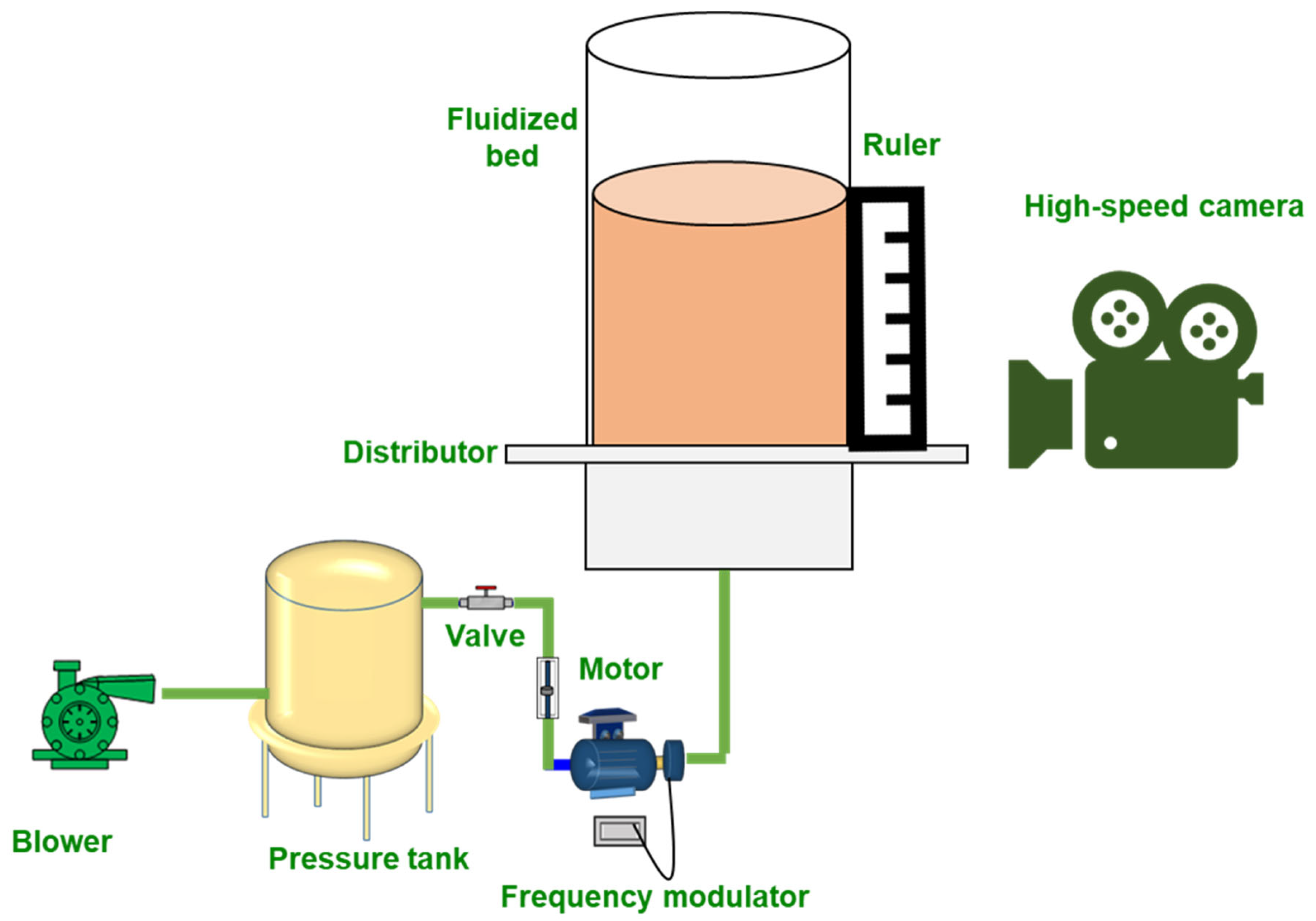
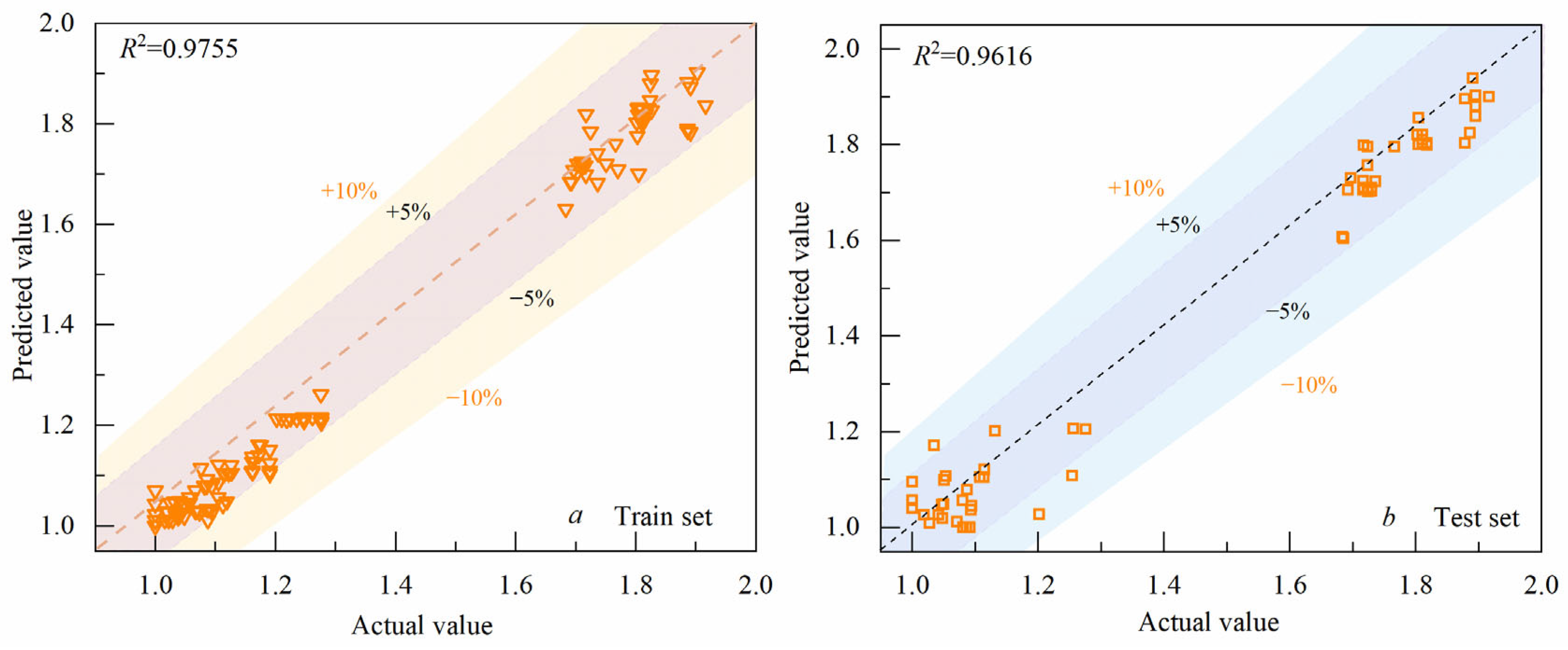

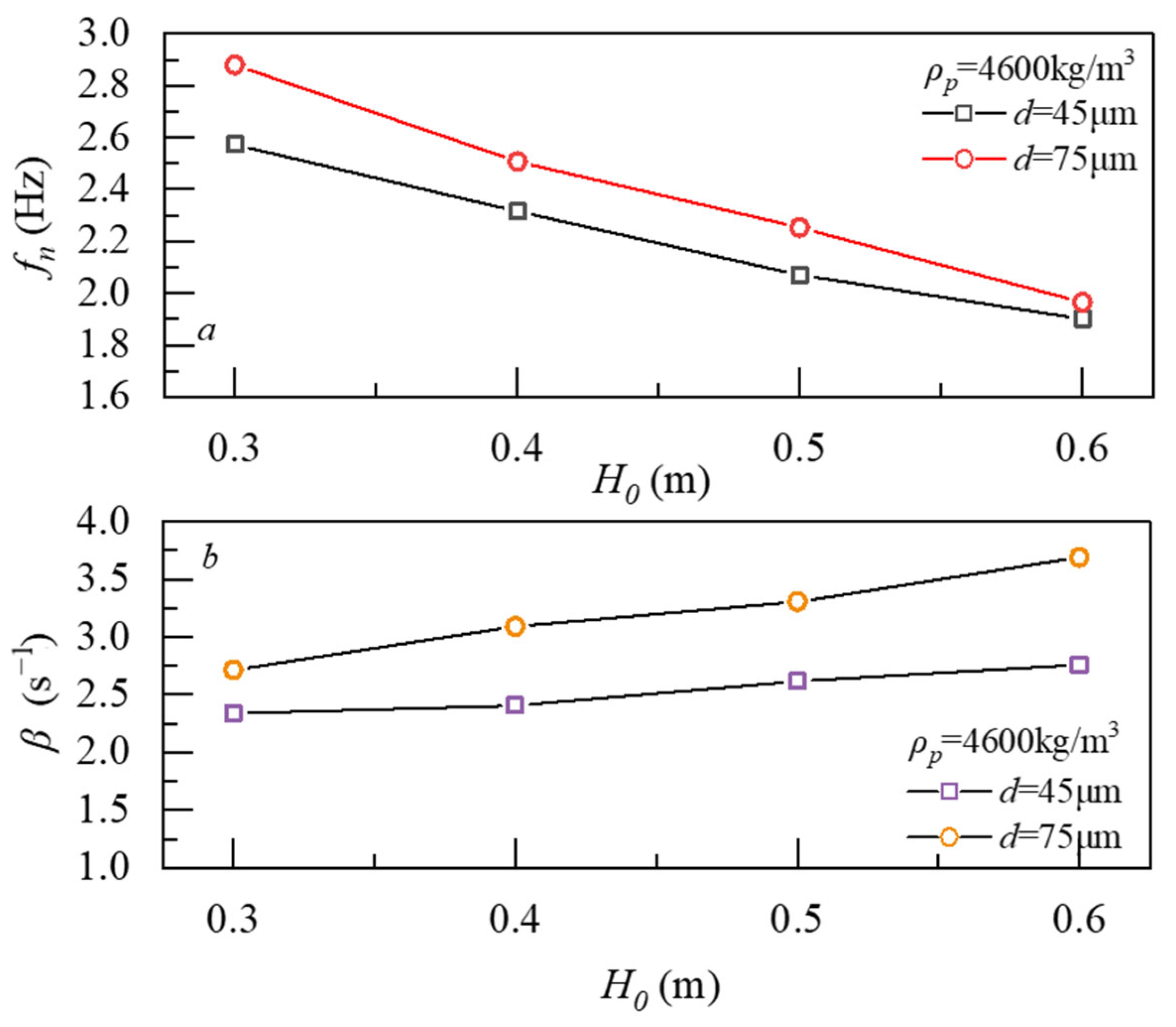
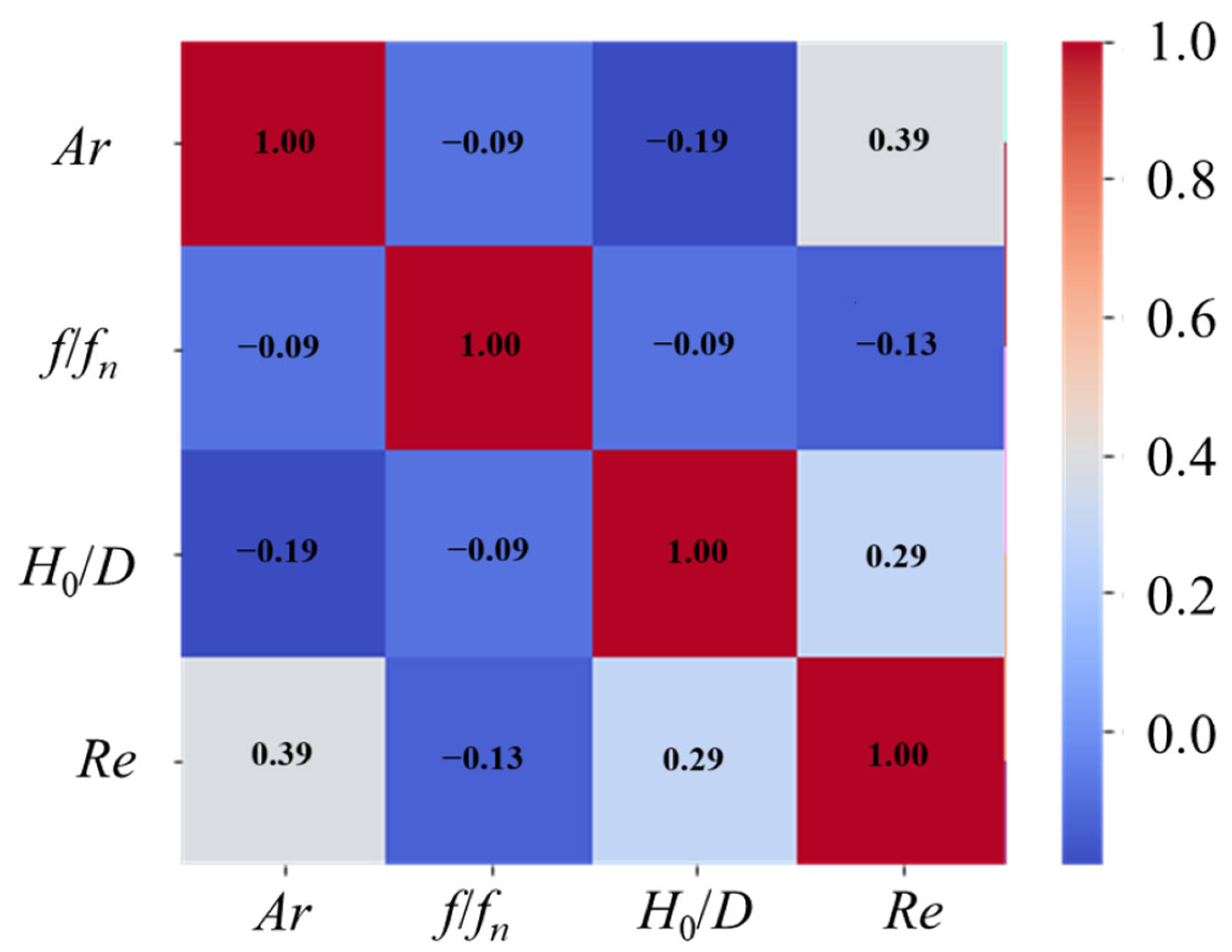
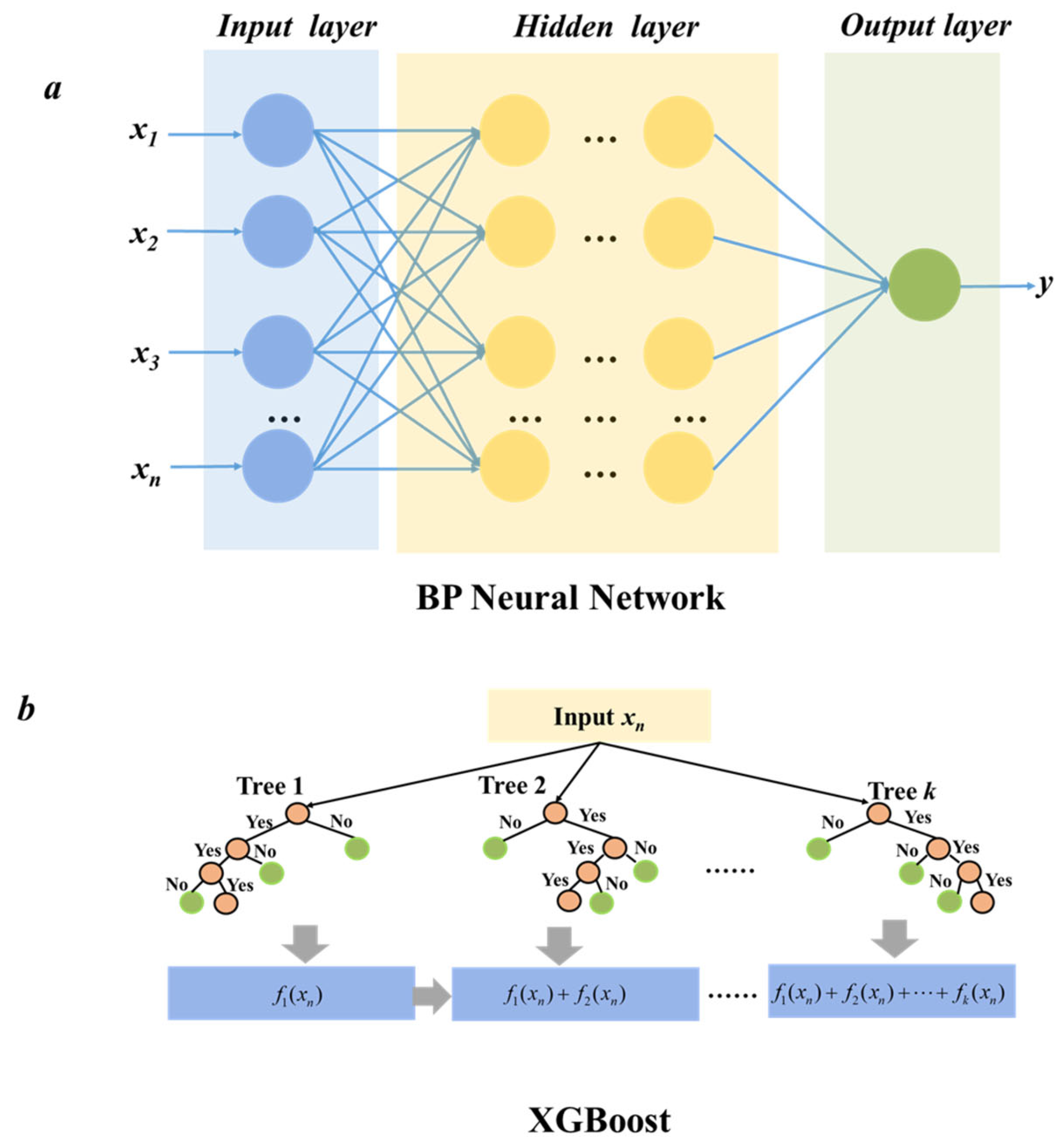
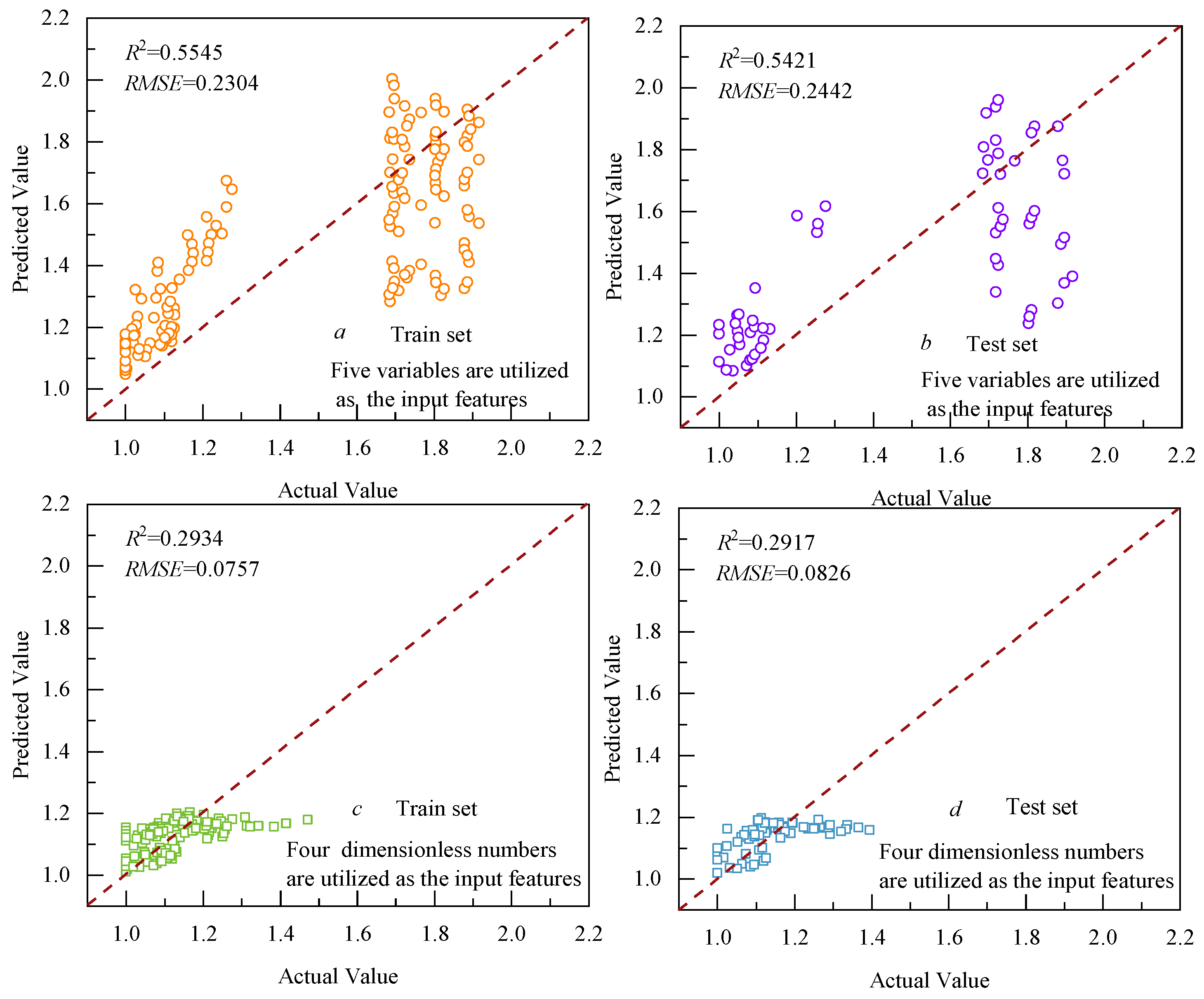
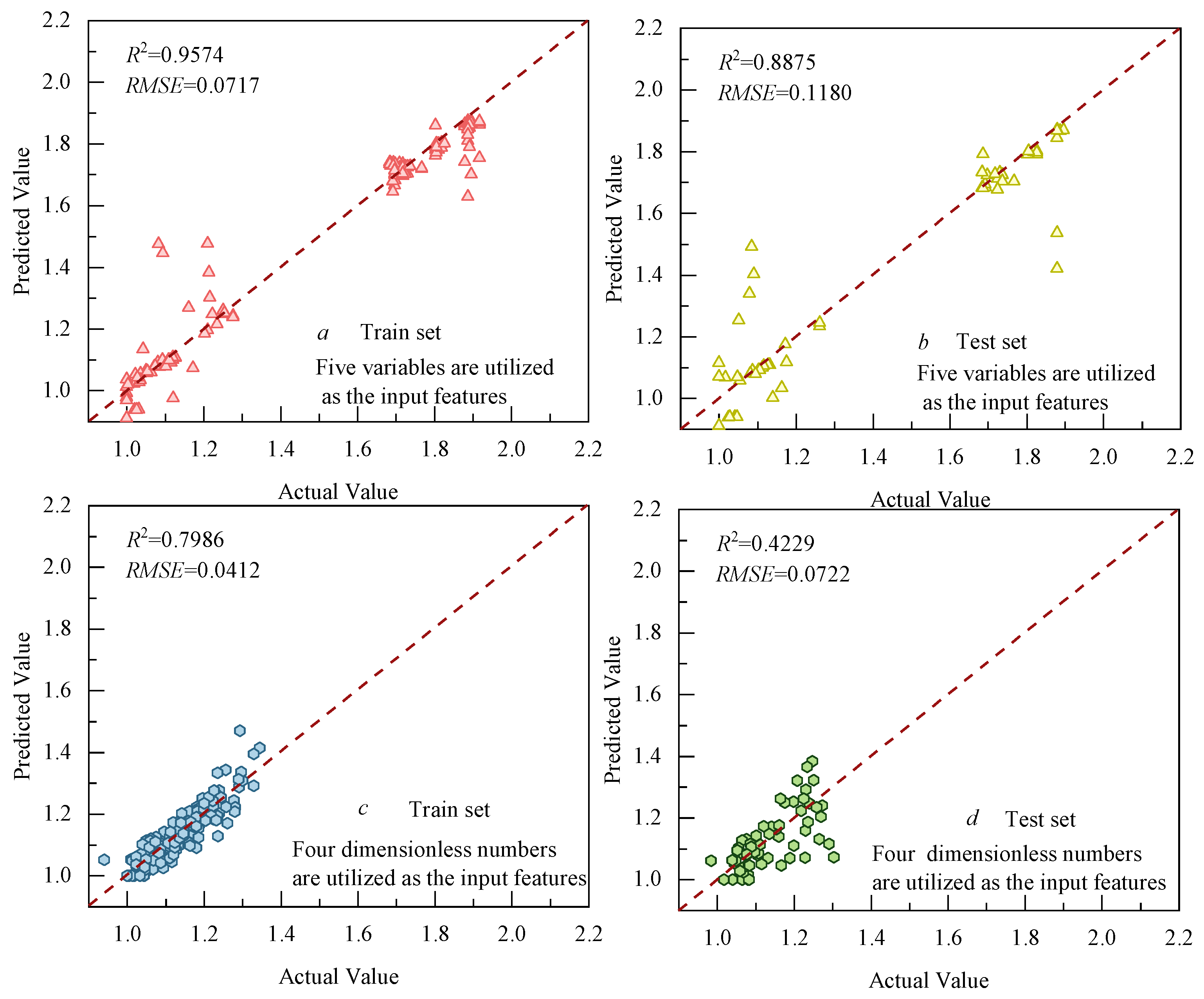
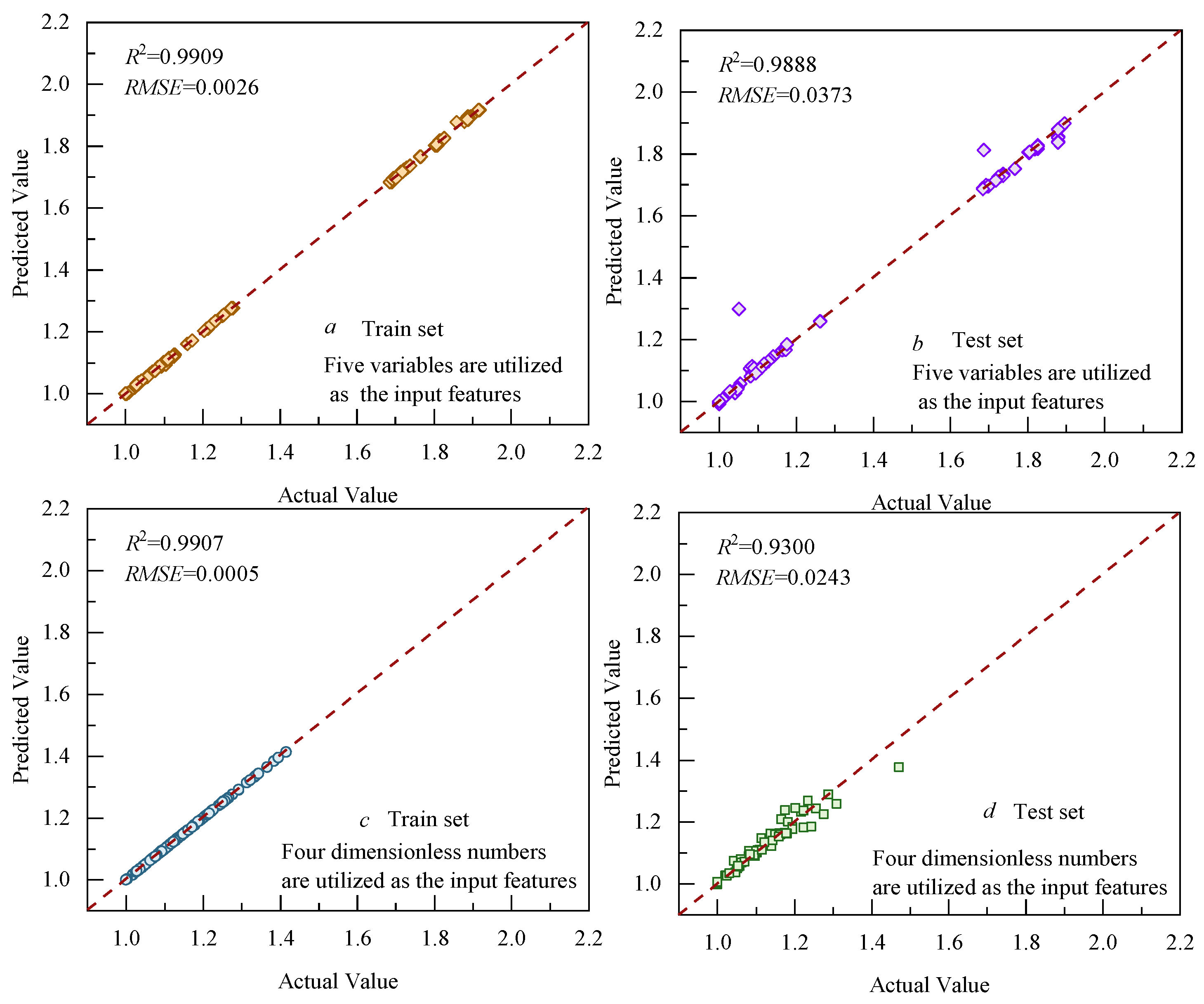

| Number | Types of Particles | Particle Size Ranges (μm) | True Density (kg/m3) |
|---|---|---|---|
| 1 | Magnetite powder A | 45 | 4600 |
| 2 | Magnetite powder B | 75 | 4600 |
| 3 | Magnetite powder C | 100 | 4600 |
| 4 | Quartz sand A | 75 | 2660 |
| 5 | Quartz sand B | 120 | 2660 |
Disclaimer/Publisher’s Note: The statements, opinions and data contained in all publications are solely those of the individual author(s) and contributor(s) and not of MDPI and/or the editor(s). MDPI and/or the editor(s) disclaim responsibility for any injury to people or property resulting from any ideas, methods, instructions or products referred to in the content. |
© 2025 by the authors. Licensee MDPI, Basel, Switzerland. This article is an open access article distributed under the terms and conditions of the Creative Commons Attribution (CC BY) license (https://creativecommons.org/licenses/by/4.0/).
Share and Cite
Li, Y.; Jiang, H.; Hong, K.; Dong, L. Prediction and Interpretative Analysis of Bed Expansion Ratio in Pulsed Fluidized Beds. Separations 2025, 12, 80. https://doi.org/10.3390/separations12040080
Li Y, Jiang H, Hong K, Dong L. Prediction and Interpretative Analysis of Bed Expansion Ratio in Pulsed Fluidized Beds. Separations. 2025; 12(4):80. https://doi.org/10.3390/separations12040080
Chicago/Turabian StyleLi, Yanjiao, Heng Jiang, Kun Hong, and Liang Dong. 2025. "Prediction and Interpretative Analysis of Bed Expansion Ratio in Pulsed Fluidized Beds" Separations 12, no. 4: 80. https://doi.org/10.3390/separations12040080
APA StyleLi, Y., Jiang, H., Hong, K., & Dong, L. (2025). Prediction and Interpretative Analysis of Bed Expansion Ratio in Pulsed Fluidized Beds. Separations, 12(4), 80. https://doi.org/10.3390/separations12040080






